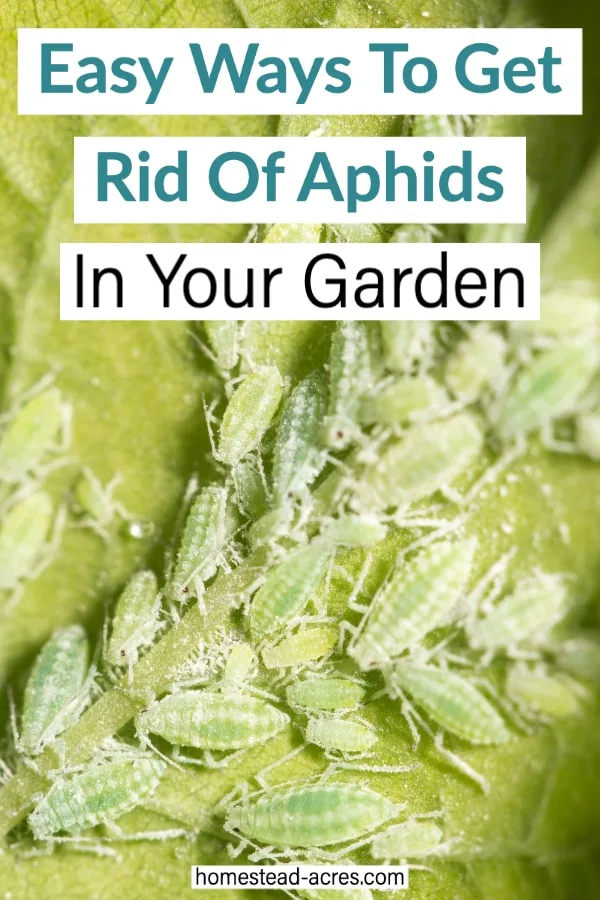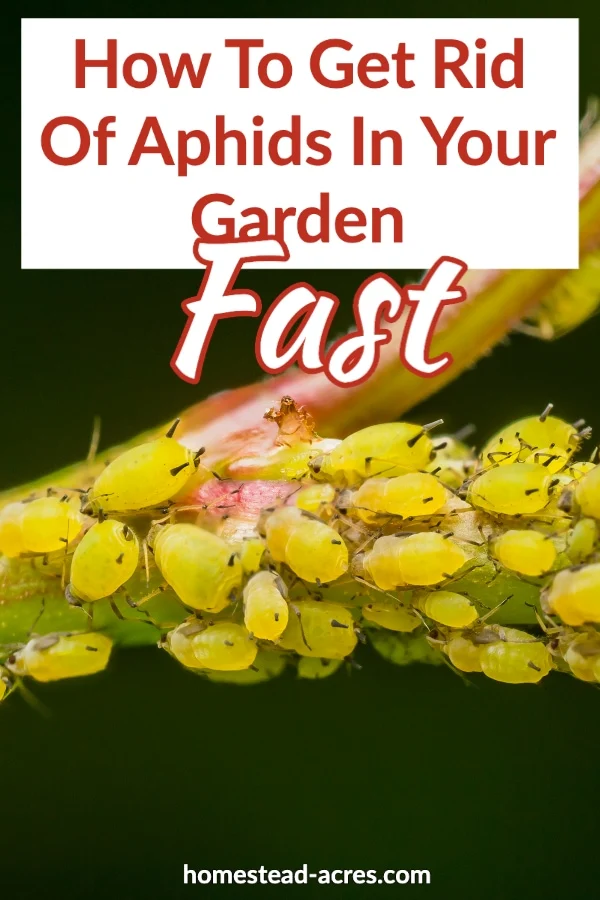This post may contain affiliate links, my full disclosure can be read here. As an Amazon Associate I earn from qualifying purchases.
Are you wondering how to get rid of aphids in the garden?
Don’t worry although aphids can cause a lot of damage to your plants they are easy to get rid of. Using natural ways to control them such as water, insecticidal soap, or neem oil is very effective.
Aphids are one of the most common garden pests in home gardens.
They can cause a lot of damage quickly to your plants.
But the good news is they are actually one of the easiest pests to control.
The first thing you’ll want to do is learn how to identify aphids so that you know this is the pest you are dealing with.
Then you can use organic methods to control them.

What Are Aphids?
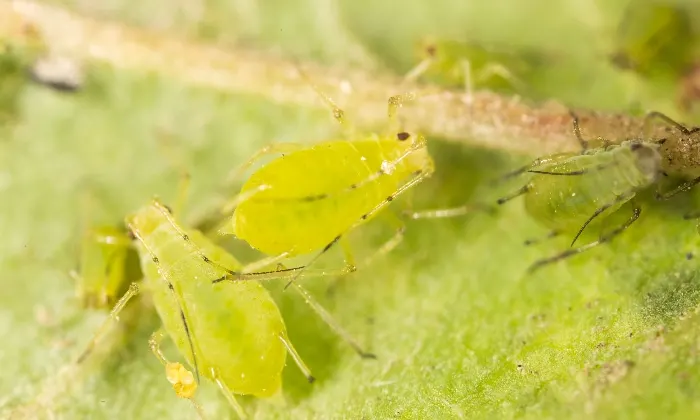
Aphids are small, soft-bodied insects that suck sap from plants.
They are found in just about all growing zones and are a common pest for gardeners. Aphids can have many generations in one season and can quickly become a bad pest so it’s best to get them under control quickly.
Identification
Aphids are very tiny insects and are often hard to notice in your garden. The adults are less than 1/4 inch (6.35 mm) in size.
They have pear-shaped bodies and long antennae. There are many species of aphids and they can be found in many colors such as green, white, grey, black, brown, yellow, and pink.
Most types have two tubes (called cornices) projecting from their backside.
Adult aphids are normally wingless but they can develop wings when they become overcrowded. This lets them move to a new feeding ground easier.
Are There More Than One Type Of Aphid?

Aphids will feed on a wide range of plants but there are some types that are specific to certain types of plants.
For example:
- Bean aphids
- Cabbage aphids
- Melon aphids
- Potato aphids
- Green peach aphids
- Wooly apple aphids
- Pear aphids
Aphid Damage
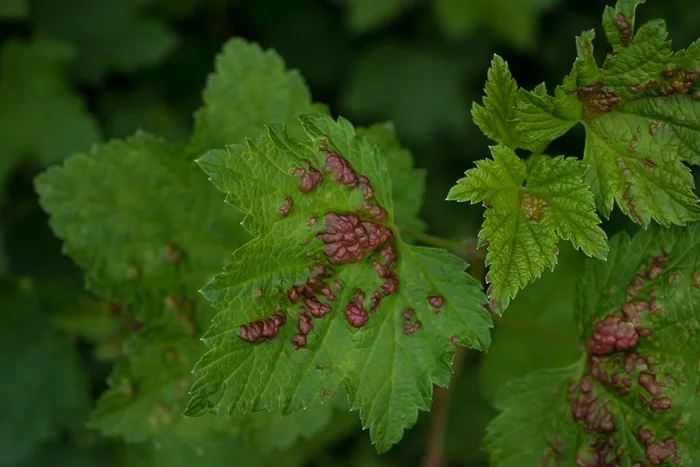
Both the nymphs and adult aphids feed on the plant juices.
They attack the leaves, buds, stems, flowers, fruit, and even roots. But the damage can depend on what type of aphid you are dealing with.
Aphids tend to prefer to eat on tender new growth so that’s a good place to start looking for damage.
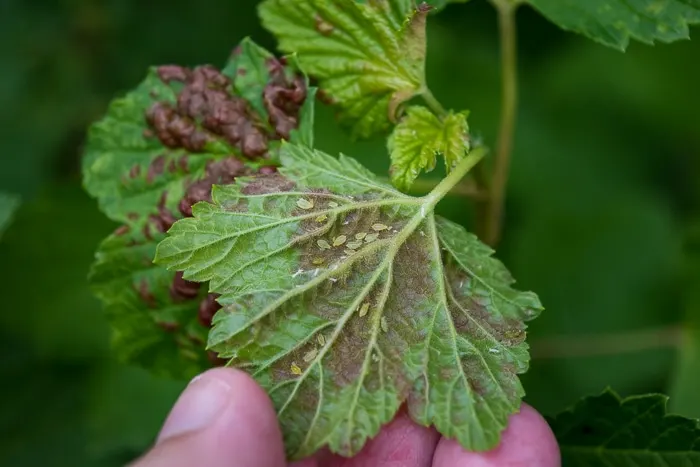
The first sign you have an aphid problem is the odd appearance of the leaves. They start to look curled, misshapen, and yellowish.
Then the leaves will often turn a red color and look like the leaves are blistered.
If you see these signs in your garden make sure to check on the undersides of the leaves for aphids.
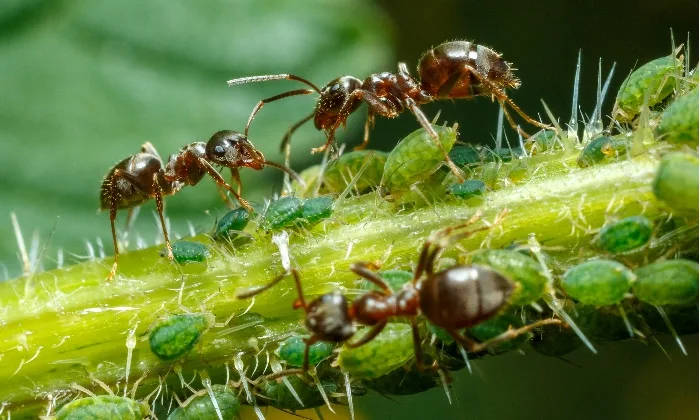
If the leaves or stems are covered with an odd sticky liquid this is also a sign that aphids have been feeding on your plants.
This sugary liquid often called “honeydew” is a waste of the insects.
It often attracts other insects such as ants because they like the sugary taste. Ants will actually groom and care for aphids just to collect the honeydew they make.
Sometimes this sweet liquid also causes sooty mold to grow, making leaves and branches look black.
How To Get Rid Of Aphids In Your Garden
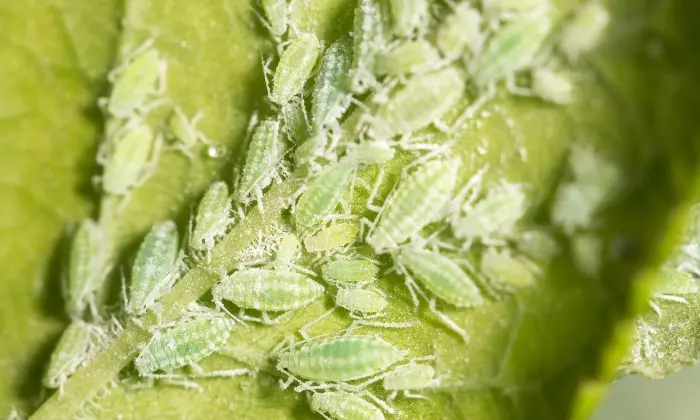
1. Water Spray
When you find aphids on your plants the first thing you should do is spray them with a strong stream of water.
This dislodges them from the plants and often they can’t find their way back.
2. Neem Oil
Neem oil is a natural repellent for aphids and many other garden pests. But it can also repel beneficial insects too so take care in how you use it.
This natural oil interferes with insect hormones and makes it harder for them to grow and lay eggs.
3. Insecticidal Soap
Insecticidal soap is a really easy way to control aphids too. You can buy it premade or make your own. Just remember to apply it under the leaves where the aphids are hiding.
4. Diatomaceous Earth
Food grade diatomaceous earth (DE) is an organic powder that will kill aphids and any other insects that comes into contact with it.
This powder is very sharp to them and causes cuts in their exoskeleton making them dry out.
It’s easy to sprinkle on plants as needed but not quite as easy to apply to the undersides of the leaves where aphids normally hide.
How To Prevent Aphids
1. Proper Watering
Aphids are often attracted to plants that are stressed by lack of water. So after removing the aphids make sure that you are watering your plants consistently.
2. Kill The Eggs
To help keep aphids off trees and shrubs you can spray them in the winter with a horticultural oil that will kill the overwintering eggs.
3. Beneficial Insects
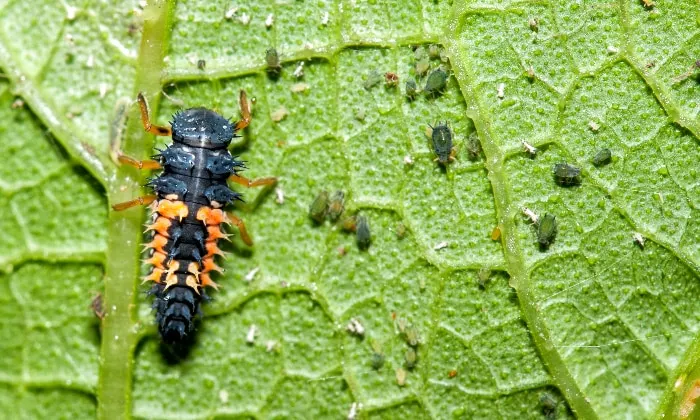
Creating a balanced habitat in your garden that attracts beneficial insects is a great way to reduce aphid damage.
There are many insects that feed on aphids such as lady beetles, parasitic wasps, and lacewings. You can even order ladybugs and parasitic wasps online to get started.
4. Companion Planting
Companion planting can also help to lower aphid problems in your garden.
Some bugs just don’t like certain plants, and some plants help to mask the scent of others making it harder for the pest to find them.
Plants that repel aphids are:
Along with companion planting, you can use trap crops to lure them away from your important plants.
Aphids love nasturtiums and mustard so planting these in a corner of your garden can help keep aphids off your other plants. Then when you see them starting to damage your trap crop you can spray them to get rid of them easily in one place.

How To Get Rid Of Aphids In Your Garden
Equipment
- Garden hose
- Sprayer
Materials
- Water
- Neem oil optional
- Insecticidal soap optional
- Diatomaceous earth optional
Instructions
- When aphids first arrive on your plants use a strong spray of water to dislodge them. Many will not find their way back to the plant.
- Neem oil is another organic pesticide that works well for both killing and preventing aphids. Spray the leaves of your plants following the directions on the bottle. Make sure to get under the leaves where aphids hide.
- Insecticidal soap is a cheap option for killing aphids too. Spray the leaves remembering to get the undersides as it has to contact the aphids to work.
- Diatomaceous earth works well to kill many insects including aphids. Try applying it as a liquid so that it’s easier to get under the leaves. Once it dries it will be effective.
How To Prevent Aphids
- Water your plants constantly. Plants that are stressed for water are more likely to have aphid damage.
- You can kill aphid eggs before they hatch by applying a horticultural oil on trees and shrubs to kill overwintering eggs.
- Encourage beneficial insects such as ladybugs, lacewings and parasitic wasps in your garden by planting flowers and herbs that attract them.
- Use companion planting to help prevent aphids. Plant herbs such as catnip, chives, dill, fennel, and cilantro or vegetables such as garlic and leaks to repel aphids from plants. Marigolds help too and look very pretty in your vegetable garden.
- You can try using trap crops such as nasturtiums one of their favourite flowers to feed on in a corner of your garden to lour them away from your other plants.
Connect With Homestead Acres!
Be sure to follow me on social media, so you never miss a post!
Facebook | Twitter | Pinterest | Twitter
Visit my Amazon store to find all my favorite gardening, homesteading tools, and gadgets plus all of my printed garden books and journals!

Kim Mills is a homeschooling mom of 6 and lives on an urban homestead in Ontario, Canada. Blogging at Homestead Acres she enjoys sharing tips to help you save money, grow and preserve your own food.


